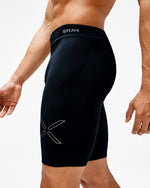Ski clothing
- This is actually a no-brainer. For good preparation, there is nothing more important than good ski clothing. Still, this is the most common beginner mistake. Especially beginners do not always want to spend hundreds of euros on a good ski suit and get on the slopes in their jeans. Believe us, it happens all too often. Also believe us when we say that these people will unlearn it very quickly. After one fall, your pants are completely covered in snow and before you know it your legs have turned into two icicles. So make sure you wear ski clothes that are not only comfortable, but are also sturdy, water-repellent and windproof.
Gloves
- Gloves are also very important to have with you. Moreover, it is still very dangerous if you go on the slopes without protection on your hands! These must also be able to take a beating and be water-repellent and windproof. Are you going to snowboard? Then make sure you buy gloves where the fingertips have extra protection (made of rubber or an extra layer of textile). Snowboarders will regularly touch the snow with their fingertips when cornering, so if you buy normal ski gloves, chances are you can throw them out after a week. A waste of money of course!
Ski socks
- As you may know, ski socks are much thicker than normal socks and ensure that your legs and feet stay warm. In addition, winter sports are particularly intensive and your leg muscles will be subjected to considerable strain. The Skiing Socks from STOX Energy are extra thick and warm compression socks specially made for the winter sports enthusiasts among us. These socks promote blood circulation in your leg muscles and ensure that your legs are less likely to be overloaded. This will prevent you from getting tired legs. Ok very honest, tired legs during winter sports is almost inevitable (especially if you go for the first time), but with these compression socks you will definitely last much longer. This way you get the most out of your winter sports holiday! In addition, the socks ensure that waste and moisture in your leg muscles are removed even better, so that your legs stay dry. Very handy when you're standing in the freezing cold!
- TIP: In addition to the Skiing Socks, STOX Energy also has special compression stockings that promote muscle recovery: the STOX Recovery Socks. It is best to put these on when you have arrived at your hotel or chalet in the evening. With this you will suffer less from muscle pain the next morning and you can go hard again the next day!
Goggles
- Sunglasses that provide sufficient protection against sunlight are a must-have for every winter sports enthusiast. Precisely because you are so high in the mountains, the UV rays are extra strong. A few hours of skiing or snowboarding without goggles and the risk of snow blindness is therefore very high. This means that the retina of your eyes has been damaged and in the worst case, your eyes should not be exposed to sunlight for 48 hours. That is of course a great waste of your winter sports holiday!
- Well, it is no problem at all to put on normal sunglasses - as long as they provide sufficient protection against the sun. Nevertheless, we recommend getting ski goggles (also called storm goggles). These glasses completely close the area around your eyes so that 'unfiltered' light has no chance to enter your eyes. However, if the weather is beautiful and you are après-ski with a beer in hand, normal sunglasses are nice to have with you. ;-)
Helmet
- Nowadays you see it more and more often that people wear a ski helmet while skiing or snowboarding. In fact, it is now seen as the basic equipment of every winter sports enthusiast - and that's a good thing! In the past, it may have been anything but cool to hit the slopes in a helmet. Let's face it: lying in a hospital because you flew with your head against a pole or rock is not something to be proud of either. Wearing a helmet on the slopes in Austria, Switzerland, France and Italy is not legally required, but there is a good chance that this will change in the future. Whether or not it is mandatory, we say: do it!
- TIP: If you buy a helmet, keep in mind that you have goggles that fit on it. It is wise to have your ski goggles with you as soon as you buy a helmet - or vice versa ;-). A waste of money if you bought glasses and a helmet that do not fit together!
Thermo underwear
- Believe it or not, when you spend a few hours stunting on the slopes you will sweat a lot - no matter how cold it is. If there's one thing you definitely don't want, it's being drenched in sweat in your ski suit. This is not only annoying, it is also life-threatening. If you stand still long enough while your clothing is damp or even soaking wet under your ski suit, your body temperature will drop very quickly. Just like compression socks, thermal clothing ensures that the moisture does not remain in your clothing and that it drifts off so that it quickly evaporates again. So a set or two of thermal underwear is a must!
Sunscreen
- One of the most common beginners mistakes is not to apply sunscreen. Hey, it's winter after all, -10 degrees Celsius and it's cloudy. What's the worst that can happen, right? Believe it or not, even in winter you can burn super fast - even when the sun isn't shining! Finally, the UV radiation in the mountains is a lot more powerful than at sea level and is twice as powerful due to the reflection in the snow. Winter sports sun also increases the risk of skin cancer. Good sunscreen contains an SPF (Sun Protection Factor) of at least 30, but it is best to have a bottle of factor 50 with you.
- TIP: Lip balm such as Labello is certainly not a bad idea to have with you. Your lips will dry out very quickly because of the dry and cold air!
Tools/Toolkit
- A toolkit or a small tool set is certainly not a bad thing to have with you. It is possible that a screw of the binding on your skis or snowboard has vibrated loose. When it comes to bindings, that's the last thing you want to be moving! That is why it is always wise to have a pocket screwdriver at hand, for example. However, putting a few loose screwdrivers in your backpack is anything but a good idea. Just the thought that it could stab you in the back during a miserable fall! NOPE! We really liked this pocket screwdriver!
Appropriate shoes
- Getting your own snowboard or skis might be a thing of the past for now. Understandable, but it is still advisable to purchase your own ski boots or snowboard boots, because that is after all very hygienic. When trying on, keep in mind that your feet cannot slide too far forward or back. It is best that your toes just touch the ends of the shoes when you stand up. Once your boots are fully engaged and you are in a bent position on your snowboard or skis, your feet will automatically be as far back as possible.
- TIP: Before trying on your ski boots or snow boots, put on your ski socks (from STOX ;-)). After all, ski socks are a lot thicker than normal socks. It's a shame if you find out on the slopes that your shoes are too small or - even worse - your feet start to pinch!
First aid kit
- Of course we hope you never have to use it, but especially with winter sports, an accident is in a small corner. Of course we don't want to discourage you, but even with the very best and sturdiest ski clothing you have no guarantee that you won't get injured. For example, you can get a scratch in your face from a tree branch you just passed. For example, a small bandage box with plasters, bandages and disinfectants comes in handy!
In short: take care of sturdy and warm ski clothing, ski goggles, a bottle of sunscreen, ski socks from STOX and the other items mentioned above and you're all set! It will undoubtedly cost a lot of money, but if you have stocked up on all this, you are guaranteed to be able to use it for many more winter sports seasons! Are you curious about how our compression socks or our Skiing Socks work? Or do you have a few good tips that we forgot to mention? let us know!












